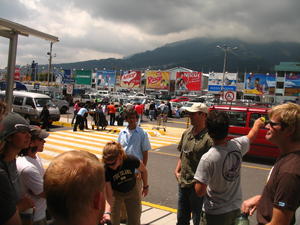Advertisement
Published: January 25th 2007

 Quito Airport Curb
Quito Airport Curb
Looking out at Quito, I saw a city that was alive with a vibrancy I had never seen.
Thanksgiving, 2006
Flying to Quito. Finished reading “The Way Out” by Craig Childs. The last chapter and discussion were awesome, articulating so well so many things that I have thought. Started “A Walk in the Woods” by Bill Bryson.
I was excited by the unknown adventures that awaited me, and it was nice to be around latin people again in the terminal in Houston. On the plae, I sat next to Jean, a French-Ecuadorian who gave me tips on the country (Biscocho and Queso de Ajo are a must in Cayambe). Pilsener is the cerveza mas mejor.
The flight into Quito was the wildest I have ever been on. As we approached the high Andean city, the pilot informed us that we would need to fly in a holding pattern over the city for a while due to fog. We had been warned about this. Quito and much of the Andes are positioned in between the Pacific Ocean and the Amazon Rain forest. Everyday, as the sun warms these two very different climate zones, the air rises up both sides of the mountain range, cooling as it climbs. When the air of these very different climates mix at high

 The Bus to Pifo
The Bus to Pifo
From there, we hopped on a bus to Pifo, a town outside of Quito.altitudes, it is the meteorological equivalent of a blender. Because this is all triggered by the warming action of the sun, the rain pretty much works like clockwork here.
After holding in the air for 30 minutes, we received clearance to land in Quito. As we descended, the window showed a scene of clouds, then fog, then more fog. When we finally broke through the fog, the city was startlingly close below. So much so, that the pilot abruptly jerked the plane up, let it fall, jerked it up again, let it fall again, then pulled us out of there and back into the sky. I could not see in front of the plane, but judging from the pilot’s reaction, I imagined that when we broke through the fog, the runway was either not where we expected it (if there at all) or not as long as we expected it. I later learned from a flight attendant that the Quito airport is one of the most difficult international airports in the world to land in due to weather, altitude, obstacles (the runway might be the only flat surface in the city), and the length of runway, which is short and in the heart of the city.
After holding for another 30 minutes, we diverted to
Guayaquil, an industrial city on the coast. Continental took great care of us and put us up in a comfortable hotel, where my roommate and I were faced with a moral dilemma. You see, the mini bar stored treasures the likes of which we had not access to in what felt like eons; fruit that we had been specifically forbidden to indulge in or risk expulsion from the course. We are talking about beer here folks, and let me tell you, after over two months of disciplined sobriety (having had several opportunities), that
Pilsener tasted like it just might be the nectar of the gods.
The next morning, after juevos and Café con Leche in the hotel restaurant, the bus had us to the airport by 8:00 a.m., and we landed in
Quito around 11:00. Standing outside on the airport curb, I felt the excitement that came from watching what once looked like the end of my adventure transform into something that felt very much like a beginning. Looking out at Quito, I saw a city that was alive with a vibrancy I had never seen.
From there, we hopped on a bus to Pifo, a town outside of Quito.
Advertisement
Tot: 0.085s; Tpl: 0.008s; cc: 7; qc: 24; dbt: 0.0398s; 1; m:domysql w:travelblog (10.17.0.13); sld: 1;
; mem: 1mb

 Quito Airport Curb
Quito Airport Curb
 The Bus to Pifo
The Bus to Pifo